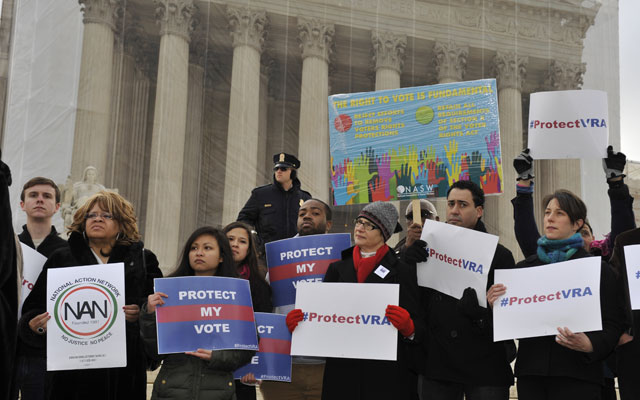In the midst of a large rally and protest on the steps of the Supreme Court building this morning, the Justices sharply questioned both sides in Shelby County, Alabama vs. Holder. This is the case challenging the continued constitutionality of Section 5 of the Voting Rights Act, an emergency provision passed by Congress in 1965 that was originally supposed to terminate after five years. It was renewed for a fourth time in 2006 for another 25 years.
Section 5 requires certain covered jurisdictions (nine states and parts of seven others) to get the preapproval of the federal government before they can make any changes in their voting laws. The main provision of the Voting Rights Act, Section 2, which is a nationwide, permanent ban on racial discrimination in voting, is not at issue in the case.
The heart of Shelby County’s challenge is the refusal of Congress in 2006 to update the triggering formula for coverage. Because of the large disparity in registration and turnout in 1965 between black and white voters that was the result of persistent and widespread discrimination, jurisdictions subject to federal preclearance in 2013 are those that had voter registration or turnout below 50 percent in the 1964, 1968, and 1972 presidential elections.
Under the current rate of registration and turnout of voters, neither Shelby County nor Alabama would be covered under Section 5. The disparity between black and white election participation has virtually disappeared in the covered states and is actually better than in many other parts of the country that are not covered by Section 5.
Shelby County’s attorney, Bert Rein, argued to the Justices that “the South has changed” and current conditions do not justify Section 5, which the Court itself recognized in 1966 was an extraordinary and unprecedented intrusion into state sovereignty.
Supreme Court Justice Sonia Sotomayor was the first justice out of the gate with very sharp questioning of Rein in a hearing that ran almost 20 minutes longer than the hour allotted. She asserted, incorrectly, that Alabama and particularly Shelby County continue to have bad discrimination records in voting.
In fact, in the past 12 years, the Justice Department has only objected to one voting change submitted for review from any jurisdiction in Alabama and has not objected to a statewide submission in almost 20 years. That objection was to a redistricting in a small town in Shelby County over whose city government Shelby County has no control. Much of the so-called evidence of discrimination that Sotomayor (and Justice Elena Kagan) kept referring to was shredded as inaccurate by the dissenting judge in the District of Columbia Court of Appeals in the lower court’s decision in the Shelby case.
Solicitor General Donald Verrilli, who was arguing the case for the Obama Administration, was unable to answer some crucial questions posed by the Justices. For example, Chief Justice John Roberts asked Verrilli if he knew which state has the worst disparity between black and white registration and turnout today, a crucial question given Section 5’s focus in 1965 on that disparity. Verrilli was unaware that the answer is Massachusetts, which is not one of the states covered by Section 5.
The Chief Justice then asked Verrilli if he knew which state was the best in terms of having no disparity. Again, Verrilli did not know that the answer was Mississippi, a state that is covered by Section 5. This is clear evidence that Section 5 no longer reflects actual conditions around the country.
When the Chief Justice asked Verrilli whether citizens of the South are today more racist than citizens of the North (and therefore should be under special supervision by the federal government), Verrilli refused to answer the question. Verrilli was forced to admit to the Chief Justice that in 2005, the year before Section 5 was renewed because of the supposed continuing pattern of “widespread” discrimination in covered states, the Justice Department lodged only one objection to 3,700 submissions. That is hardly evidence of a continuing pattern of persistent discrimination in the covered jurisdictions.
When asked, Verrilli had no idea how many lawyers at the Justice Department even work on Section 5 reviews.
Despite Verrilli’s constant reference to the legislative record established by Congress when Section 5 was renewed, he was unable to establish that the exceptional conditions that justified Section 5 in 1965 still exist today and require the “extraordinary” remedy of Section 5. Instead, he kept referring to the past history of the South—as if stuck in a time warp.
Verrilli also did not have a good answer to the question of why Section 2 was not an adequate remedy for instances of discrimination when they do occur.
Justice Antonin Scalia panned the overwhelming votes Section 5 received when it was renewed in the House and Senate, saying that it amounted to a “perpetuation of racial entitlement.” No Member of Congress would have anything to gain according to Scalia (and everything to lose) in voting against Section 5 because of the political costs of such a vote. Scalia said he was confident that Section 5 will be renewed in perpetuity by Congress.
The Supreme Court was sharply split at oral argument today, and that will no doubt be reflected in the written opinions. But whether the Court will uphold Section 5 or strike it down is anyone’s guess.




























